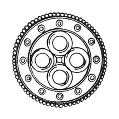Monk then Prior at Christchurch Canterbury, later Abbot at Peterborough, also known as Benedict of Peterborough
The following text is based on a recent lecture and publication by Dr Rachel Koopmans from York University, Toronto.
Very little of Benedict’s early life is known, though he likely had Anglo-Norman parents and may have been born in Kent. His facility with Latin and close knowledge of the Bible and the liturgy strongly suggest that he entered the Benedictine monastery of Christ Church, Canterbury, as a youth. He was in Canterbury Cathedral on the day Thomas Becket was murdered, December 29, 1170, and witnessed the beginning of pilgrimage to Becket’s tomb in the cathedral’s crypt. He started to record pilgrims’ miracle stories from late spring 1171. Two and a half years later, by the end of 1173, he had completed his collection of some 275 stories. He also wrote an account of the sequence of events leading up to Becket’s death. After Becket was canonised in February 1173, Benedict composed the liturgical Office for Canterbury’s new saint. This Office was utilised throughout Europe to celebrate the anniversity of Becket’s death.
From 1173 onwards Benedict was promoted several times. He became chancellor to Archbishop Richard of Dover (Becket’s successor) and later (mid-1175) he was elected prior at Canterbury. He took early responsibility for the early rebuilding of the Quire and Trinity Chapel (after the disastrous fire of 1174). He moved to Peterborough (seemingly required to do so by King Henry II) to become Abbot in mid-1177, and stayed in that role until his death on September 29, 1193. On his departure from Canterbury he took several Becket relics including the paving stones on which Becket had died and a large number of manuscripts. At Peterborough, he proved to be an excellent administrator, but he returned to Canterbury many times. He would have seen the rebuilt cathedral filled with stained glass, though most of the famous “miracle windows” in the Trinity Chapel were not installed until after his death.
The life of Benedict is of particular interest, not just because he was a very successful prior, abbot and administrator, but also because he was a witness and recorder of one of the most important and shocking events in English history. He took great care to speak to pilgrims and describe in considerable detail a large number of miracles reported to him or observed by him between 1171 to 1173. As stated by Rachel Koopmans (Reference 1 below), Benedict’s work is readable, relatable, and jam-packed with drama, and one of the most extraordinary texts produced by a medieval British writer. None of the Christ Church copies of Benedict’s collection survived the Reformation, but the thirteenth-century copy that was at St Augustine’s Abbey is held at Trinity College, Cambridge, and has been digitised (See reference 2 below). There is no complete surviving copy of Benedict’s Passion narrative, but much of the text is included in a medieval compilation of the lives of Becket known as the Quadrilogus II and has been translated by Koopmans.
Some of the miracle stories described by Benedict are depicted in glorious detail and colour in surviving early medieval glass on the north and south side of the Trinity Chapel of Canterbury Cathedral.
IO June 2025
References
Note: If you follow the links in the first reference there is an option to select “Open Access” and download a pdf copy of the new translation of Benedict’s passion and miracles St Thomas Becket.
THE PASSION AND MIRACLES OF ST. THOMAS BECKET BY BENEDICT OF PETERBOROUGH (2025) TRANSLATED BY RACHEL KOOPMANS. The Boydell Press, Woodbridge ISBN 978 1 83765 264 8 (Hardback) ISBN 978 1 83765 271 6 (Paperback) ISBN 978 1 80543 626 3 (ePDF) https://boydellandbrewer.com/9781837652716/the-passion-and-miracles-of-st-thomas-becket-by-benedict-of-peterborough/
Benedicti Petriburgensis Miracula S. Thomae (Benedict of Peterborough, Miracles of St Thomas). Trinity College, Cambridge MS B.14.37: https://mss-cat.trin.cam.ac.uk/Manuscript/B.14.37
